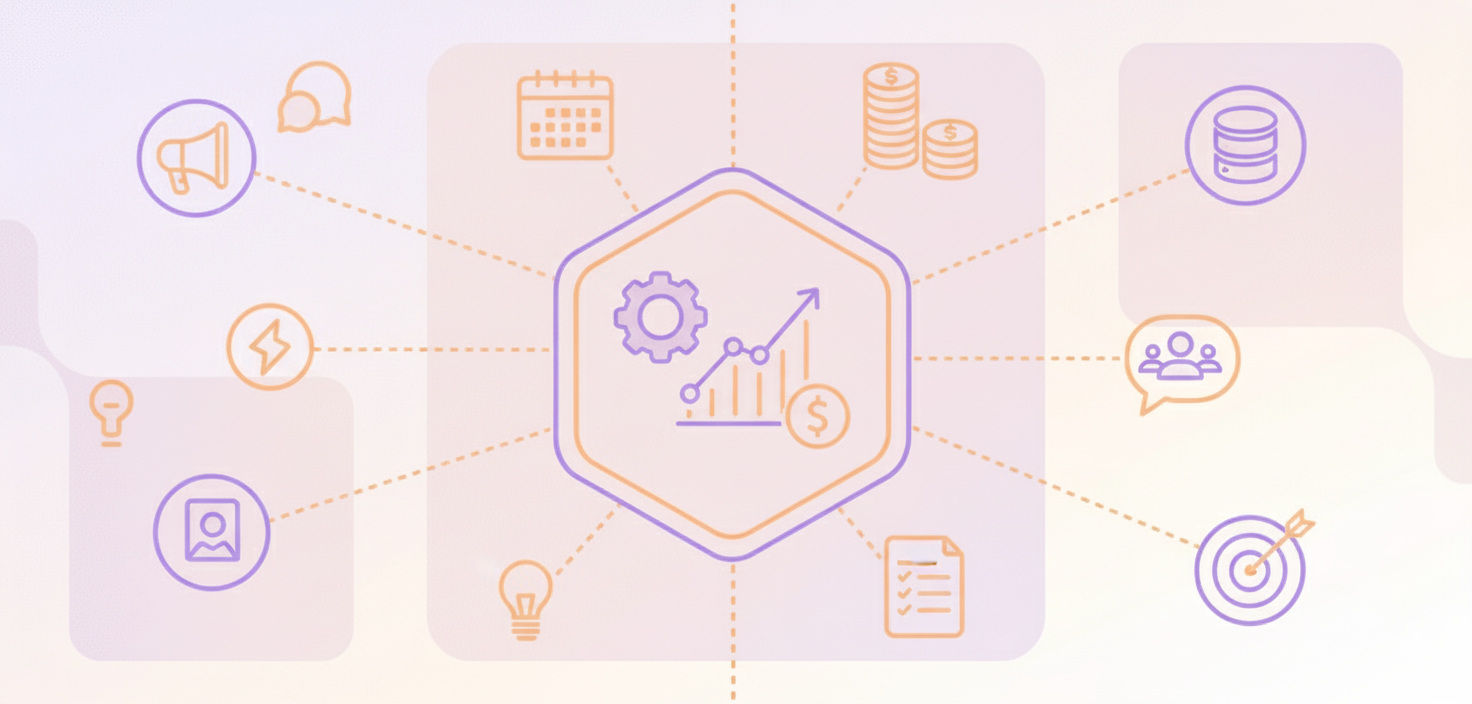Opérations de mise à l'échelle
Qu'est-ce qu'un cadre RevOps SaaS ?

Qu'est-ce qu'un cadre RevOps SaaS ?
Un cadre RevOps SaaS est une approche qui aligne les organisations de marketing, de vente et de succès client vers un objectif de revenus partagé.
Pour y parvenir, il doit y avoir des processus clairs, des mesures et une gestion rigoureuse de l'information.
Pourquoi les RevOps sont-elles importantes pour le SaaS ?
La RevOps peut impacter les entreprises SaaS en influençant leur potentiel de croissance soutenue.
La RevOps est associée à des changements de revenus et de bénéfices en influençant les processus et en extrayant des informations exploitables à partir des données.
Enfin, la RevOps vise à mettre en place une stratégie claire qui influence l'expérience client, ce qui a des implications pour l'activité SaaS.
Quelles sont les principales différences entre les RevOps et les Opérations Ventes/Marketing ?
Voici une comparaison côte à côte entre la RevOps et la SalesOps :
|
Concept |
Portée |
Objectif |
|
RevOps |
prend en charge l'intégralité de l'entonnoir de revenus, incluant le marketing, les ventes et la réussite client |
superviser tous les aspects du processus de revenus, incluant le développement de nouvelles affaires, la rétention et l'expansion client, et la préparation du marché pour la génération de prospects |
|
SalesOps |
soutient uniquement l'équipe de vente |
améliorer l'efficacité de l'équipe de vente en matière de conclusion d'affaires. |
Quels sont les composants clés d'un cadre RevOps SaaS ?
Les éléments clés d'un cadre RevOps SaaS incluent :
- alignement des processus
- alignement des équipes
- une pile technologique connectée
- prise de décision axée sur les données.
Sans connecter les technologies, les outils, et aligner les processus ainsi que l'équipe, un cadre RevOps aura du mal à obtenir des résultats optimaux.
Les éléments clés d'un cadre RevOps SaaS incluent :
- alignement des processus
- alignement des équipes
- une pile technologique connectée
- prise de décision axée sur les données.
Sans connecter les technologies, les outils, et aligner les processus ainsi que l'équipe, un cadre RevOps aura du mal à obtenir des résultats optimaux.
Quels sont des exemples de cadres RevOps réussis ?
Le RevOps est un concept qui a été adapté pour répondre aux exigences spécifiques d'une entreprise.
L'accent est mis sur la standardisation et l'optimisation des processus à travers les ventes, le marketing et la réussite client, ce qui peut affecter la prévisibilité des revenus.
Des exemples de ces cadres incluent :
- SiriusDecisions Demand Waterfall – Cadre de revenus B2B et de génération de demande
- TOPO – Fait généralement référence au cadre de vente TOPO
- Gartner – Fait référence à la méthodologie de vente Gartner
- Modèle Bowtie – Le modèle d'entonnoir Bowtie (un modèle de revenus montrant l'acquisition → l'expansion → la rétention).
- Flywheel HubSpot – Le modèle Flywheel de HubSpot (un cadre de croissance centré sur l'élan généré par le succès client).
- RACI – Responsable, Imputable, Consulté, Informé.
- Modèle basé sur les OKR – Objectifs et Résultats Clés.
- PEAS – Performance, Environnement, Actionneurs, Capteurs (de la conception des systèmes d'IA).
Tous ces cadres mettent l'accent sur la nécessité de processus efficaces et efficients, ainsi que sur l'utilisation des données.
De même, les grandes entreprises utilisent également des outils tels que :
Le choix du modèle doit être basé sur une compréhension des objectifs commerciaux et du parcours client.
Comment évaluer votre pile technologique RevOps ?
Voici les étapes pour évaluer votre pile technologique RevOps :
- Préparez une évaluation des opérations et des processus déjà en place en mettant l'accent sur leur efficacité.
- Définir des objectifs clairs compatibles avec la stratégie commerciale et les initiatives RevOps.
- Surveiller régulièrement les performances du stack technologique et recueillir l'avis des utilisateurs sur ce qui doit être amélioré. Par exemple, si les cycles de vente sont lents, vérifiez si vos outils CRM et d'automatisation sont intégrés efficacement.
- Éliminer ou améliorer le stack technologique en fonction des données et des utilisateurs du système, de manière à ce qu'il continue de répondre aux besoins de l'entreprise.
Comment RevOps améliore-t-il la gestion des leads ?
RevOps peut influencer la gestion des leads par des effets potentiels sur l'efficacité, la relation entre le marketing et les ventes, et l'efficacité des processus.
Il en résulte :
- une meilleure génération de leads
- plus élevé les taux de conversion
- amélioré rétention client.
Les principales stratégies RevOps incluent :
- le suivi des KPIs SaaS pertinents
- l'automatisation des processus de gestion des leads
- équiper les ventes d'informations complètes sur les leads pour un engagement et une conversion efficaces.
Comment le RevOps peut-il améliorer l'alignement des équipes et réduire les frictions ?
Le RevOps influence potentiellement l'efficacité de l'équipe et les niveaux de friction via des procédures standard conçues pour aligner les équipes vers des objectifs communs.
Cela peut influencer l'efficacité du parcours client, fournir des données concernant les flux de revenus, et éclairer les décisions stratégiques.
Ces objectifs ne peuvent être atteints que s'il y a une planification et une coordination bien anticipées.
Conclusion
Une approche RevOps SaaS est cruciale pour les entreprises SaaS qui visent une croissance à long terme, en harmonisant les fonctions marketing, ventes et succès client. Ceci est réalisé par l'intégration des processus et des équipes, une pile technologique connectée, la gestion des leads et la réduction des frictions au sein des équipes. La mise en œuvre d'une stratégie RevOps, combinée à une évaluation et une optimisation régulières de la pile technologique, pourrait affecter les flux de revenus, l'engagement client et la performance durable des entreprises SaaS dans un environnement concurrentiel.